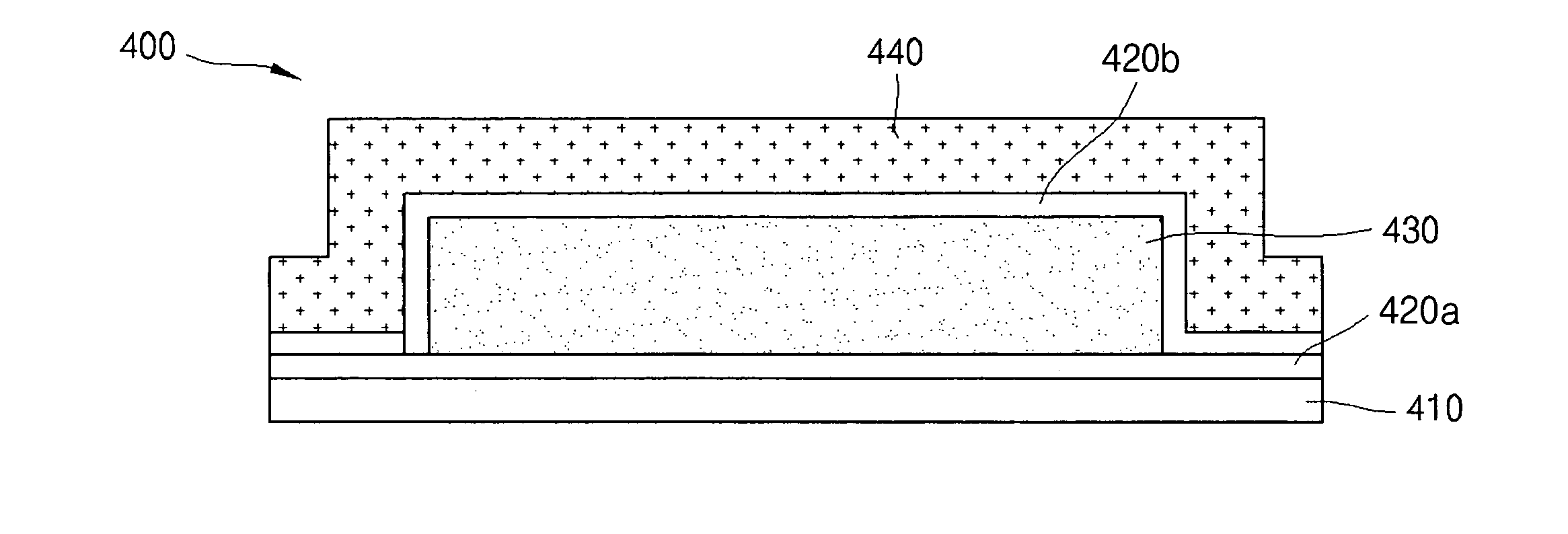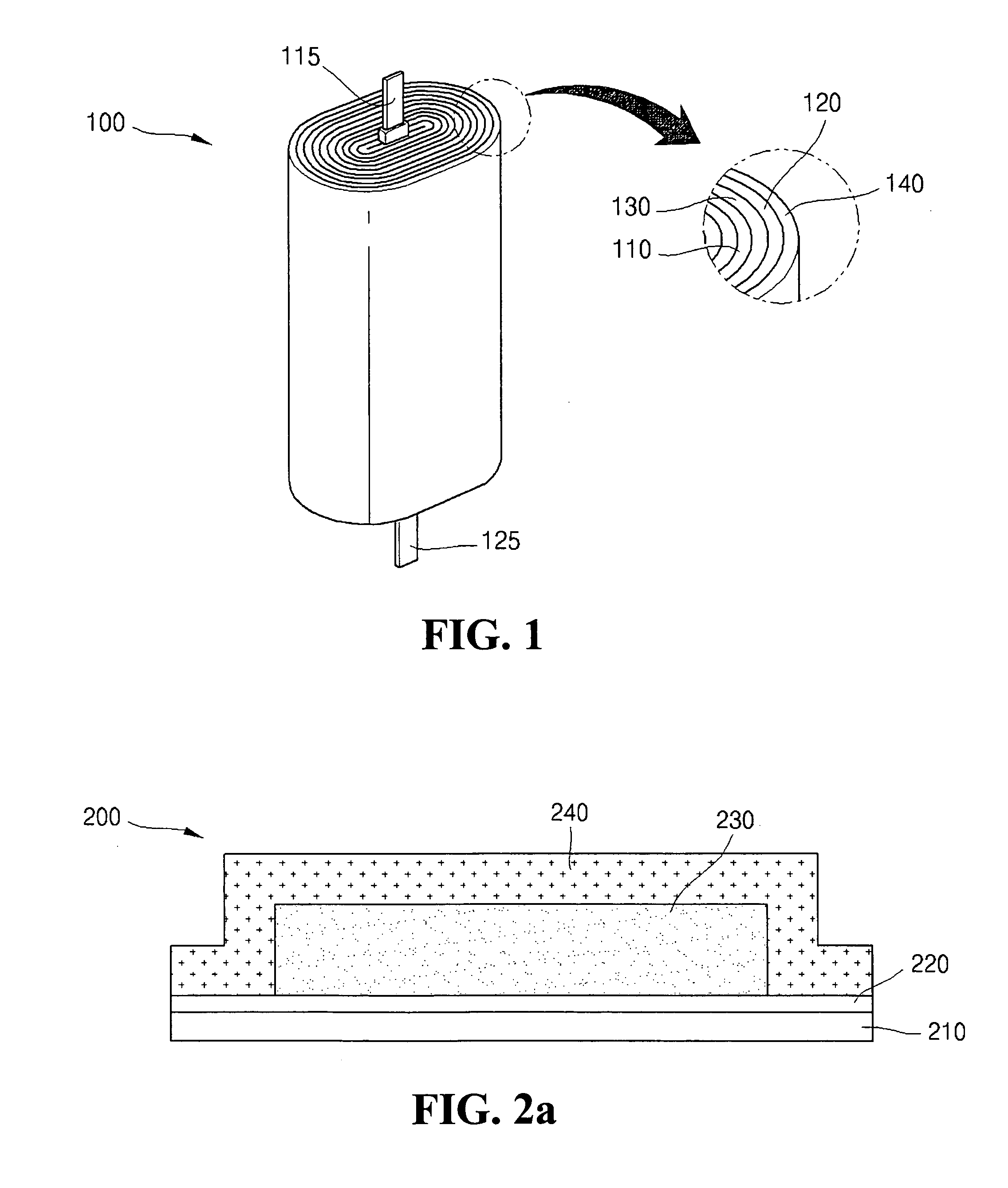Electrode including Si-containing material layer and porous film, and lithium battery employing the same
a lithium battery and porous film technology, applied in the direction of secondary cells servicing/maintenance, cell components, cell component details, etc., can solve the problems of low ohmic contact efficiency, high reactivity of lithium itself, and short circuit between electrodes, so as to improve ohmic contact efficiency and reduce contact angle , the effect of increasing the adhesion
- Summary
- Abstract
- Description
- Claims
- Application Information
AI Technical Summary
Benefits of technology
Problems solved by technology
Method used
Image
Examples
example 1
[0105] 50 g of a poly(vinylidene fluoride (PVDF) binder and 1000 g of graphite having an average diameter of 20 μm were added to 700 g of a n-methyl-pyrrolidone (NMP) solvent, and then stirred using a mechanical stirrer for about 30 minutes to prepare a negative active material slurry. The slurry was applied on a copper current collector to a thickness of about 150 μm, and dried and then further dried at 150° C. in a vacuum. Then, to form a porous film, sintered particles obtained by heating zirconium oxide at 900° C. for about 10 minutes were mixed with 95 g of the binder and 5 g of modified soluble acrylonitrile rubber (BM-720H, Zeon Co., Ltd., Japan) at a weight ratio of zirconium oxide: binder of 95:5 in 150 ml of a solvent to make a liquid mixture. The electrode plate was immersed in the liquid mixture, and the thickness of the film formed on the plate was controlled to 20 μm using a gravure roller. Then, the film was dried at 120° C., and thermally treated at 150° C. for the p...
example 2
[0106] HMDS (OAP, Tokyo Ohka Kogyo Co. Ltd) was formed on a copper (Cu) current collector to a thickness of 0.005 μm by vapor phase deposition. Then, 50 g of a PVDF binder and 1000 g of graphite having an average diameter of 20 μm was added to 700 g of a NMP solvent and stirred using a mechanical stirrer for 30 minutes to prepare a negative electrode active material slurry. Then, the slurry was applied on the copper current collector to a thickness of about 150 μm, and dried and then further dried at 150° C. in a vacuum. Then, to form a porous film, sintered particles obtained by heating zirconium oxide 900° C. for about 10 minutes were mixed with 95 g of a binder and 5 g of modified soluble acrylonitrile rubber (BM-720H, Zeon Co., Ltd., Japan) at a weight ratio of zirconium oxide: binder of 95:5 in 150 ml of a solvent to make a liquid mixture. The electrode plate was immersed in the liquid mixture, and the thickness of the film formed on the plate was controlled to 20 μm using a gr...
example 3
[0107] 50 g of a PVDF binder and 1000 g of graphite having an average diameter of 20 μm was added to 700 g of a NMP solvent and then stirred using a mechanical stir for 30 minutes to prepare a negative electrode active material slurry. The slurry was applied on a copper current collector to a thickness of about 150 μm, and dried and then further dried at 150° C. in a vacuum. Then, HMDS (OAP, Tokyo Ohka Kogyo Co. Ltd) was formed on the copper (Cu) current collector to a thickness of 0.005 μm by vapor phase deposition. Then, to form a porous film, sintered particles obtained by heating zirconium oxide 900° C. for about 10 minutes were mixed with 95 g of a binder and 5 g of modified soluble acrylonitrile rubber (BM-720H, Zeon Co., Ltd., Japan) at a weight ratio of zirconium oxide: binder of 95:5 in 150 ml of a solvent to make a liquid mixture. The electrode plate was immersed in the liquid mixture, and the thickness of the film formed on the plate was controlled to 20 μm using a gravur...
PUM
| Property | Measurement | Unit |
|---|---|---|
| thickness | aaaaa | aaaaa |
| thickness | aaaaa | aaaaa |
| temperatures | aaaaa | aaaaa |
Abstract
Description
Claims
Application Information
 Login to View More
Login to View More - R&D
- Intellectual Property
- Life Sciences
- Materials
- Tech Scout
- Unparalleled Data Quality
- Higher Quality Content
- 60% Fewer Hallucinations
Browse by: Latest US Patents, China's latest patents, Technical Efficacy Thesaurus, Application Domain, Technology Topic, Popular Technical Reports.
© 2025 PatSnap. All rights reserved.Legal|Privacy policy|Modern Slavery Act Transparency Statement|Sitemap|About US| Contact US: help@patsnap.com



